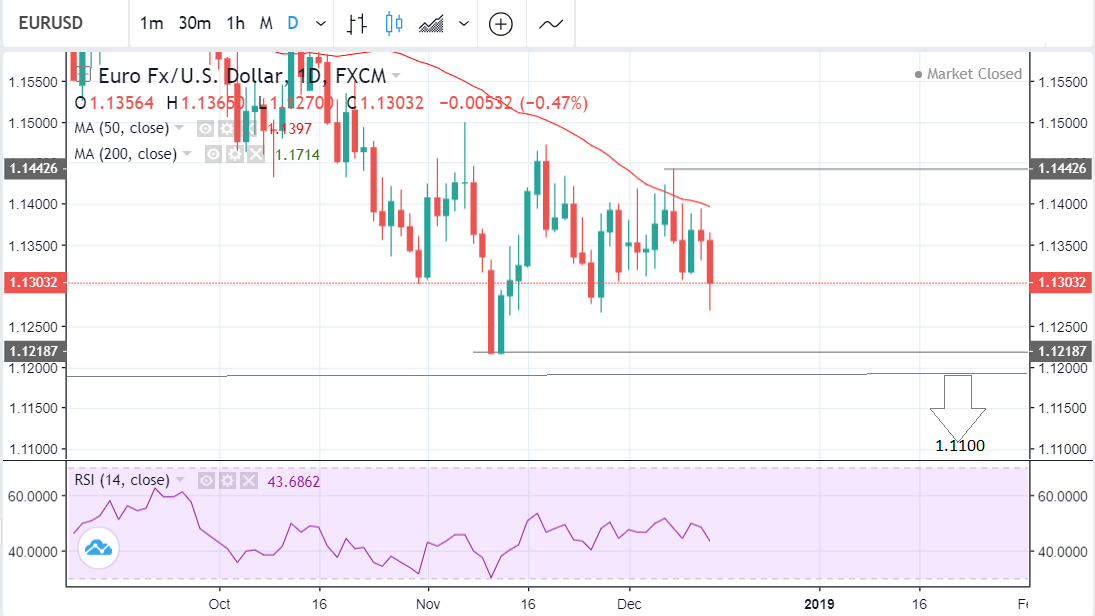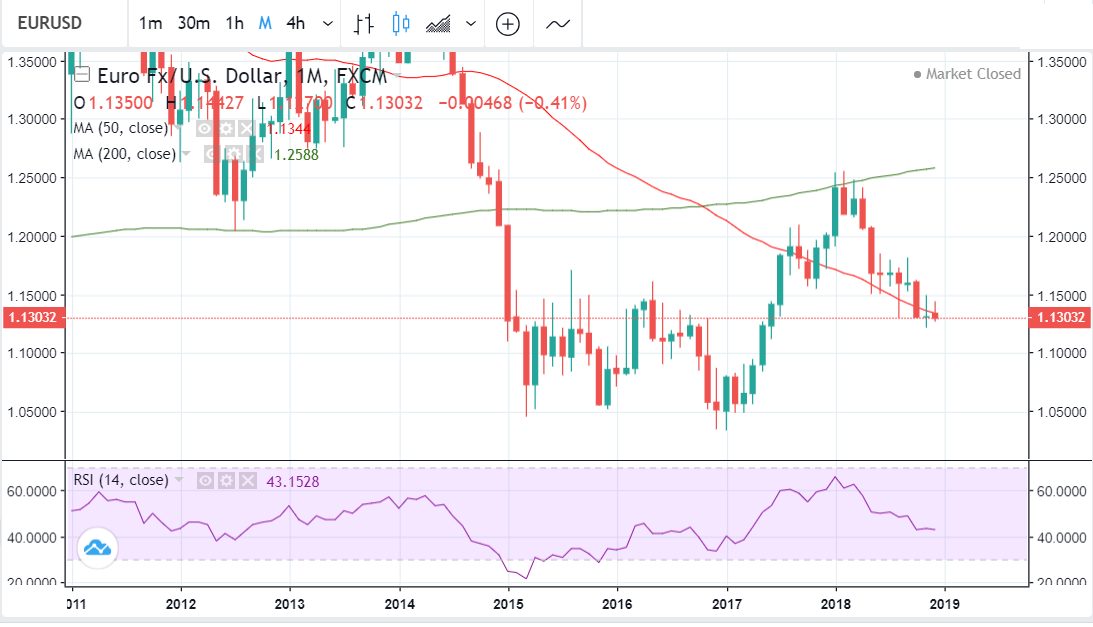The Euro-to-Dollar Rate in the Week Ahead: Range Bound with a Bearish Bias

© Grecaud Paul, Adobe Stock
- EUR/USD range bound between 1.12 and 1.14.
- Break below floor will signify further downside.
- USD eyes Fed as confidence data looms for EUR.
The Euro-to-Dollar rate has been trapped within the 1.12-to-1.14 range for several weeks now and is expected to remain within these confines during the days ahead, although its bias is to the downside.
EUR/USD closed last week at 1.1304, down 0.77% from the previous week, with the decline mainly caused by weak economic data emerging from the single currency bloc.
Weak data has reignited fears for the bloc's economy just as the end-game for the Brexit process approaches and Brexit turmoil is now rubbing off on the Euro despite it having been mainly a Sterling affair up until now.

Above: Euro-to-Dollar rate shown at daily intervals.
Forecasting whether the rate will move higher or lower within the range is a risky undertaking as prices often undergo random moves when trading in this way.
A clear break below the range lows, confirmed by a move beneath the 1.1218 November trough and the S1 monthly pivot at 1.1190, would probably open the door to a continuation down to around 1.1100.
Despite the long-term trend being down the weekly and monthly charts are giving off conflicting signals.
A key reversal (circled) formed four weeks ago on the weekly chart when the exchange rate first carved out a major low and then reversed in the same week. These moves are often associated with changes in the primary trend.
.png)
Above: Euro-to-Dollar rate shown at weekly intervals.
The weekly chart also shows the exchange rate respecting the 200-week moving average (MA) since first falling to its level nearly two months ago. This suggests the moving average could now be acting as support.
The monthly chart is showing a similar relationship between the exchange rate and the 50-month MA which is also providing support to the exchange rate at its current level.
The market having failed to break below these levels is not enough on their own to signal a reversal higher although repeated failures do make clear that it will take a significant event for the market to break lower from the current range.

Above: Euro-to-Dollar rate shown at monthly intervals.
Advertisement
Bank-beating exchange rates. Get up to 5% more foreign exchange by using a specialist provider to get closer to the real market rate and avoid the gaping spreads charged by your bank when providing currency. Learn more here
The Euro: What to Watch
The main release in the week ahead for the Euro is consumer confidence data for December, on Friday at 15.00 London time. The confidence index is expected to fall further, to -4.3, from -3.9 previously.
This could weigh on the Euro, which is already struggling due to weak activity data released last week, as it would suggest a further deterioration in the economic outlook for the bloc.
Other key releases for the single currency include the final estimate of November inflation, out on Monday at 10.00, and the balance of trade for October which is due at the same time. Current account data is out Tuesday.
The US Dollar: What to Watch
The main event for the Dollar in the week ahead is the December meeting of the Federal Reserve (Fed), on Wednesday at 20.00 London time, which is expected to see the Fed raise its interest rates for the fourth time this year.
This will take the Fed funds rate to between 2.25-2.50%, although this move is already priced into exchange rates so markets will focus on the Fed's accompanying statement and latest 'dot plot' instead.
Traders will look to those for clues about high high interest rates are likely to rise next year. Markets are only pricing one full rate hike for 2019 so anything that suggests a similar pace of hikes to that seen this year could lift the Dollar.
“Should the Fed forecast fewer rate increases in 2019 and also lower some of its growth and inflation projections, the US Dollar could come under the firing line in forex markets,” says Broker XM.com.
The personal consumption expenditure (PCE) prices are a key gauge of inflation and the Fed's preferred means to measuring price pressures.
The latest measurement is out on Friday at 14.30, alongside measures of personal spending and income growth. Both of the latter are expected to have risen by 0.3% during November.
Durable goods orders are forecast to have rebounded by 1.7% in November after a -4.4% decline in October. Durable goods orders excluding transportation items are expected to have risen by 0.3% during the period. Both figures will be released alongside the PCE numbers.
Housing data is also scheduled for release on Thursday, which will be important in light of recent economist concerns about a possible slowdown in the market.
The NY empire state and Philadelphia Fed manufacturing stats due at 14: 30 on Monday and Thursday respectively are also both key releases for the U.S.
Advertisement
Bank-beating exchange rates. Get up to 5% more foreign exchange by using a specialist provider to get closer to the real market rate and avoid the gaping spreads charged by your bank when providing currency. Learn more here




